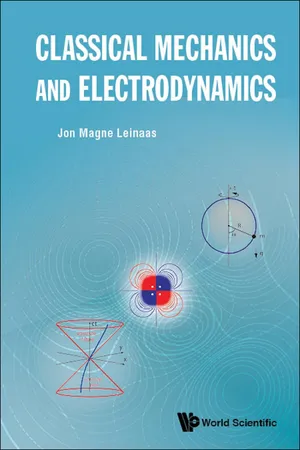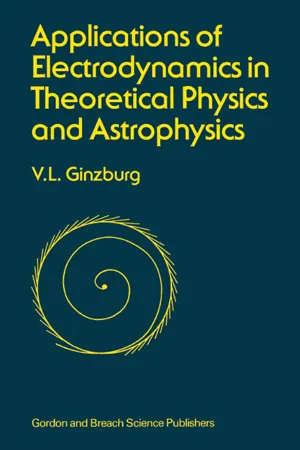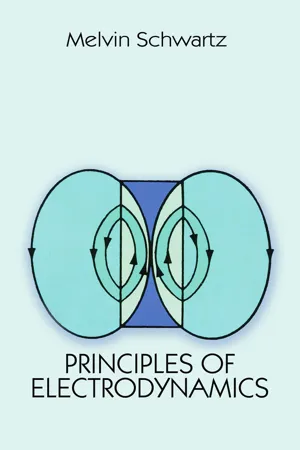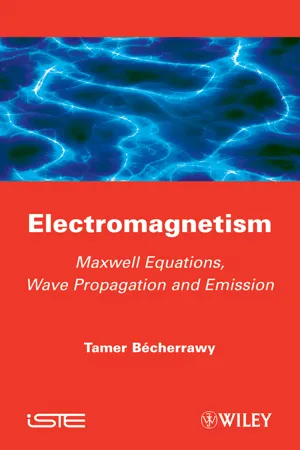Physics
Magnetic Dipole Radiation
Magnetic dipole radiation refers to the electromagnetic radiation emitted by a magnetic dipole moment when it undergoes acceleration. This radiation is characterized by its specific pattern and polarization, and it is a fundamental concept in the study of electromagnetism and the behavior of magnetic fields. Understanding magnetic dipole radiation is crucial for various applications in physics and engineering, such as in the design of antennas and magnetic resonance imaging (MRI) technology.
Written by Perlego with AI-assistance
Related key terms
Related key terms
1 of 4
Related key terms
1 of 3
4 Key excerpts on "Magnetic Dipole Radiation"
- eBook - ePub
- Jon Magne Leinaas(Author)
- 2018(Publication Date)
- WSPC(Publisher)
E2, may also under certain conditions be important, etc.As an interesting point to stress, the radiation field described by (12.46 ) and (12.47 ) appears as a direct consequence of the retardation effects. This has been clearly demonstrated in our derivation of the magnetic field B in (12.43 ). It is the derivative with respect to r through the retarded time tr that gives the field contributions that fall off with distance like 1/r, while the direct derivation of the potentials with respect to r gives field contributions that fall off like 1/r2 .Electric dipole radiationWhen the electric dipole term dominates the radiation, the expressions for the radiation field simplify to Poynting’s vector for this field iswhere the angle θ introduced in the last step is the angle between the vectors and n. The subscript ret is a reminder, that all variables at the source should be taken at the retarded time tr = t – r/c.Since S(r, t) gives the energy current density of the electromagnetic field, the above expression shows that the radiation is, as one should expect, directed in the radial direction n away from the source of the radiation. The radiation power is given as the integral of S over all angles,Fig. 12.4Angular distribution of radiated energy in electric dipole radiation from a linear antenna. The electric dipole moment p, which here oscillates along the x-axis, gives a rotationally symmetric radiation pattern about this axis. The magnitude of the Poynting vector S - David Ginsburg(Author)
- 2017(Publication Date)
- Routledge(Publisher)
n = 2 for the octupole, and so on. Hence the quadrupole radiation, for instance, is significant only if the dipole moment of the system is zero or unusually small. (This is, of course, the simplest example. The quadrupole radiation can also dominate over the dipole radiation when the frequency of variation of the quadrupole moment is higher than the frequency of variation of the dipole moment. Another significant factor can be a difference between the angular distributions (or the so-called polar diagrams) of the dipole and quadrupole radiations.)For a dipole (oscillator) whose moment p = er varies only in magnitude the electric field in the wave zone varies as E ~ sin θ and the radiation intensity (the energy flux in the elementary solid angle dΩ) is given byI ==dW sd Ω d t(2p ¨)4 πc 3θ ,sin24.1 where θ is the angle between p and the wave vector k (see Figure 4.1 ). In the case of harmonic motion, when p = ea0 sin ω0 t, (4.1) yields (1.85) averaged over time.Figure 4.1 Electric field of a stationary dipole as a function of the angle θ between the directions of p and the wave vector k.The radiation emitted by a nonrelativistic electron moving in a magnetic field is often referred to as “cyclotron radiation”. (The terms describing the radiation emitted by charges moving in magnetic fields have not yet been fully agreed upon. In our opinion we must use the already existing terms and call such radiation in the general case “magneto-bremsstrahlung radiation”, in the case of nonrelativistic particles “cyclotron radiation”, and in the case of highly relativistic particles “synchrotron radiation”. Thus, with this nomenclature, cyclotron and synchrotron radiation are the limiting special cases corresponding respectively to the nonrelativistic or weakly relativistic case and to the highly relativistic case.) The frequency of the cyclotron radiation (the dipole radiation) is of course equal to the frequency of electron rotation in the field ℋ0- eBook - ePub
- Melvin Schwartz(Author)
- 2012(Publication Date)
- Dover Publications(Publisher)
Note the amazing similarity to the expressions we obtained for electric dipole radiation. The magnetic field here has the same relation to the projected apparent magnetic dipole moment as the electric field has to the projected apparent electric dipole moment.An example of such a magnetic dipole is the simple circular current loop shown in Fig. 8-2 . We take the loop to have circumference a and let the current in the loop be given by(In this case the total length of wire involved in the antenna is the same as it is for our previous electric dipole.) We will again calculate the average energy radiated per unit time per unit solid angle and compare it directly with what was obtained in the case of the comparable electric dipole [see Eq. (8-2-15) ]. The magnetic moment of the loop is justHenceIt is instructive then to compare this result with Eq. (8-2-16) . We have, for comparable currents and a comparable size,The intensity of Magnetic Dipole Radiation is thus characteristically smaller by a factor of about (a/λ)2 than that of electric dipole radiation. (This point is of considerable significance in analyzing the radiation of atomic states. When we get to study atomic transitions, we will find that some of them cannot take place through the medium of electric dipole radiation and hence are appropriately suppressed.)Fig. 8-2 A simple current loop with current I(t) = I0 eiωt emits Magnetic Dipole Radiation.We next return to the so-called electric quadrupole potential.Consider the first part of the integral. We will examine its x component.We eliminate the first of these two integrals by converting it into a surface integral and by noting that j = 0 on the surface. HenceButand, remembering Eq. (8-2-4) ,We have thus Generalizing to three dimensions, we conclude thatSubstituting back into Eq. (8-3-13) , we find for A2 qTo proceed, we will take the curl of A2 q and find the magnetic field. Again we ignore terms of order 1/r2 .We will add to the expression on the right of Eq. (8-3-16) - eBook - ePub
Electromagnetism
Maxwell Equations, Wave Propagation and Emission
- Tamer Becherrawy(Author)
- 2013(Publication Date)
- Wiley-ISTE(Publisher)
v. These are the usual properties of electromagnetic plane waves.The energy density and the Poynting vector associated with this wave and averaged over a time equal to a period of the wave are[15.37 ][15.38 ]This means that the energy propagates in the radial direction with the velocity v. We note that the intensity of the electric dipole radiation I (DE) = <S(DE) > decreases like 1/r2 , this can be explained by the distribution of the energy over a sphere of radius r.The power of the electric dipole radiation, emitted in the solid angle dil in the direction of the angles 9 and q>, is[15.39 ]The radiation is not isotropic. The intensity of radiation vanishes in the direction of the dipole (θ = 0 or θ = π), since the fields E and B vanish in this direction. The averaged total emitted power is the flux of <S> over a sphere of radius r:[15.40 ]It may be expressed in terms of the effective intensity /eff = Im / 2= apm /d 2 as[15.41 ]Particularly, for waves in vacuum we find P(DE ) = 80tc2 (d/X)2 Ie ff2 . This power is obviously supplied by the generator of the electric current. The electric dipole consumes as much energy as if it has a radiation resistance[15.42 ]For a given intensity Ie ff, the total emitted power varies as the frequency squared, at least for large wavelengths such that kd = 2nd/k « 1.15.4. Magnetic Dipole RadiationThe magnetic moment of a loop of area S carrying a current I(t) is W( t) = SI(t). If the loop lies in the plane Oxy, 7K points in the direction Oz (Figure 15.2a ). We assume that the loop is circular with a small radius, compared to the wavelength X. The current is then approximately the same at all the points of the loop. If the current is simple harmonic of angular frequency co
Index pages curate the most relevant extracts from our library of academic textbooks. They’ve been created using an in-house natural language model (NLM), each adding context and meaning to key research topics.
Explore more topic indexes
Explore more topic indexes
1 of 6
Explore more topic indexes
1 of 4



